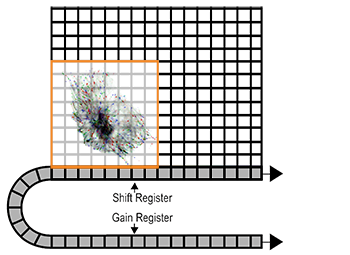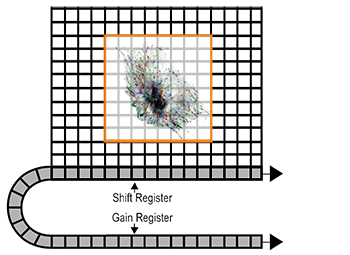Resources
 Part of the Oxford Instruments Group
Part of the Oxford Instruments Group
Expand
Collapse
 Part of the Oxford Instruments Group
Part of the Oxford Instruments Group
The iXon Ultra is capable of market leading frame rate performance. This is due to ‘overclocking’ the horizontal and vertical shifts during readout while maintaining quantitative stability. We discuss this, and how we can achieve fastest possible continuous Region of Interest (ROI) frame rates using ‘Crop Mode’.
Part 1. Overclocking horizontal and vertical shifts for fastest speeds
Maximum frame rate performance in EMCCDs is a function of two parameters; (1) Pixel Readout Speed (horizontal); (2) Vertical Clock Speed. The former dictates how rapidly charge is pushed horizontally through the EM gain register and the remaining readout electronics, while the latter dictates the speed at which charge is vertically shifted down through both the exposed sensor area and masked frame transfer area of the chip. Significant advantages are gained through optimizing the camera electronics to enable both horizontal and vertical shifts to be speeded up through overclocking.
iXon offers industry fastest vertical shift speeds, resulting in faster frame rates and reduced smearing, significantly faster under commonly employed conditions of sub-array/binning. Notably, the iXon Ultra markedly overclocks the pixel readout speed to up to as fast as 30 MHz, compared to the standard 10MHz speed, further boosting the frame rate by 3x, in the case of the iXon Ultra 888.
Part 2. Boosting ROI Frame Rates with Crop Mode
The iXon family offer Crop Mode, which carries the following advantages:
If an experiment demands fast temporal resolution, but cannot be constrained by the maximum storage size of the sensor (as is the case for ‘Fast Kinetics Mode’ of readout), then it is possible to readout the iXon cameras in ‘Crop Mode’. In this mode, the user defines a ‘ROI’ region, from the output corner of the sensor area (optically centred possible with iXon Ultra), ensuring to position the sample such that the ROI encompasses the region of the image where change is rapidly occurring (e.g. a ‘calcium spark’ within a cell). The sensor subsequently “imagines” that it is of this smaller defined array size, achieved through the camera executing special readout patterns, and reads out at a proportionally faster frame rate. The smaller the defined array size, the faster the frame rate achievable. The reason that an ROI in Crop Mode can be significantly faster than a ‘standard’ ROI, is that Crop Mode overcomes the additional readout overheads associated with the reading and dumping signal charge from the ‘unwanted’ pixels of the sensor area. In order to use Crop Mode, one has to ensure that no light is falling on the light sensitive area outside of the defined region. Any light collected outside the cropped area could corrupt the images that were acquired in this mode. For microscopy set-ups, this is now aided with an accessory called OptoMask, available from Andor. Table 1 shows frame rates that are achievable with the iXon Ultra 897 when in Crop Mode (corner tethered).
NEW – Optically Centred Crop Mode: Enabling live cell super-resolution
The iXon Ultra now comes with ‘Optically Centred Crop Mode’, which gives the user the option to break away from the corner tethered requirement of standard crop mode and select a number of pre-defined ROIs that are located in the centre of the image field. This is achieved with only minimal sacrifice in achievable frame rate, for example, in the case of the iXon Ultra 897, a 128 x 128 optically centred ROI delivering 569 fps.
Optically centring of the ROI makes this mode extremely appealing to a number of microscopy techniques, including ‘pointillism’ live cell super-resolution microscopy. For example, the iXon Ultra 897 can be operated in full 512 x 512 resolution at a frame rate suited to generation of fixed cell super-resolved images, then Optically Centred Crop Mode can be invoked with a 128 x 128 ROI for generation of super-resolved live cell images showing dynamic events. Table 2 shows frame rates possible from Optically Centred Crop Mode for a range of ROI sizes.
Crop Mode is ideally suited to a number of challenging applications across many diverse fields of research. In terms of technology match, Crop Mode is particularly well suited to the many dynamic applications of EMCCD cameras. The fundamental advantage and a distinct feature of EMCCD technology is its ability to virtually eliminate the camera readout noise detection limit at any readout speed. This allows EMCCD detectors to be successfully used for applications where raw sensitivity and exposure time requirements ultimately prevent the use of conventional CCD systems
In biological imaging, Crop Mode can be successfully used to enhance performance and throughput in super-resolution ‘pointillism’ applications including STORM, PALM and PALMIRA. Imaging frame rates exceeding 500 fps can be readily achieved from a 128 x 128 ROI (optically centred in the case of the iXon Ultra), making it the ideal camera for live cell super-resolution measurements.
Crop Mode can also be employed to achieve extremely fast temporal resolution in ion signalling measurements, such as observing calcium sparks. Samples labelled with voltage sensitive dyes also benefit from extremely fast imaging, with thousands of frames per second not being uncommon. There is also potential to use cropped EMCCDs for Fluorescence Correlation Microscopy (FCS), using multiple points or light sheet illumination. The mode is furthermore suited to multi-spectral fluorescence confocal scanning, as an alternative to the arrays of PMTs that have traditionally been used in this approach. The greater than 90% Quantum Efficiency of the back-illuminated sensor, single photon sensitivity, array architecture and rapid pixel readout speed can be exploited to markedly improve this approach. The laser dwell-time should be set to coincide with the time to expose and read-out a short row of approximately 32 pixels - sufficient spectral channels to yield effective un-mixing of several known emitting dyes, resulting in a data cube of 512 x 512 x 32 (spectral) taking less than 1 second to generate. There is a clear sensitivity advantage of EMCCD pixels over the usually employed PMT-technology, which is circa 5-fold in the blue-green and up to tenfold in the red.
There are many physical science applications that can benefit from the speeds of Crop Mode, such Bose Einstein Condensation (BEC) or lucky astronomy. EMCCD-based adaptive optics, for which smaller format EMCCD sensors are often used, can also benefit from this mode of readout. The iXon Ultra can be operated with a 128 x 128 ROI at a rate of almost 600 fps, readily pushing to > 1000 fps with binning, frame rates that are adaptable even to planetary adaptive optics.
| ‘Standard’ Region of Interest (ROI) | ||||||
|---|---|---|---|---|---|---|
| Binning | 256x256 | 128x128 | 64x64 | 512x96 | 512x32 | 512x1 |
| 1x1 | 110 | 212 | 397 | 277 | 704 | 2857 |
| 2x2 | 210 | 394 | 699 | 503 | 1136 | - |
| 4x4 | 384 | 680 | 1099 | 840 | 1613 | - |
| ‘Cropped Mode’ Region of Interest (ROI) – Optically Centred Crop Mode in brackets | ||||||
|---|---|---|---|---|---|---|
| Binning | 256x256 | 128x128 | 64x64 | 512x96 | 512x32 | 512x1 |
| 1x1 | 111 (174) | 595 (569) | 1433 (1492) | 296 | 857 | 11074 |
| 2x2 | 215 (329) | 1085 (1014) | 2432 (2329) | 570 | 1589 | - |
| 4x4 | 402 (594) | 1802 (1662) | 3577 (3237) | 1050 | 2682 | - |
Table 1 – Frame rates achievable by the iXon Ultra 897 under both ‘Standard’ ROI and ‘Crop Mode (corner tethered)’
| Centralized ROI Size (no binning) | Frame Rate |
| 256 x 256 | 174 |
| 192 x 192 | 310 |
| 128 x 128 | 569 |
| 96 x 96 | 869 |
| 64 x 64 | 1,492 |
| 32 x 32 | 3,024 |
Table 2 – Frame rates achievable by the iXon Ultra 897 operated in ‘Optically Centred Crop Mode’.


Figure 1. Crop Mode: The active imaging area of the sensor is defined in a way that only a small section of the entire chip is used for imaging. The remaining area has to be optically masked to prevent light leakage and charge spill-over that would compromise the signal from the imaging area. By cropping the sensor one achieves faster frame rates because the temporal resolution will be dictated by the time it requires to read out small section of the sensor. The ROI can be defined either at the output corner (a), or selected from a pre-defined list of optically centred ROIs (iXon Ultra only).
